Health Care Issue Analysis: Gun Violence and Mental Health
VerifiedAdded on 2022/08/12
|13
|3798
|38
Report
AI Summary
This report provides a comprehensive analysis of the multifaceted issue of gun violence, examining its various dimensions and impacts. The report begins with an introduction outlining the scope of the problem, particularly in the United States, highlighting the significant toll it takes on individuals, families, communities, and the national economy. It then delves into the main issue, exploring the prevalence of gun violence, its economic costs, and the psychological effects on victims, including mental health conditions such as PTSD. The analysis covers specific vocabulary and understanding of gun violence, including acts of violence, psychiatric illnesses, firearms, and related concepts. The report examines different positions on the issue, including the role of media violence, cultural factors, and mental health, as well as the influence of gun laws. Strongest positions of support and opposition are discussed, particularly regarding gun laws and the impact of gender discrimination, domestic abuse, and a history of violence. The report concludes by presenting a personal position, advocating for restrictions on gun licensing and possession rather than a complete ban, emphasizing the need to address underlying causes like violent behavior and substance abuse. The report underscores the importance of a balanced approach that considers both public safety and individual rights. The report is structured around the assignment brief which focuses on issue analysis and the development of a reasoned response to the issue of gun violence.
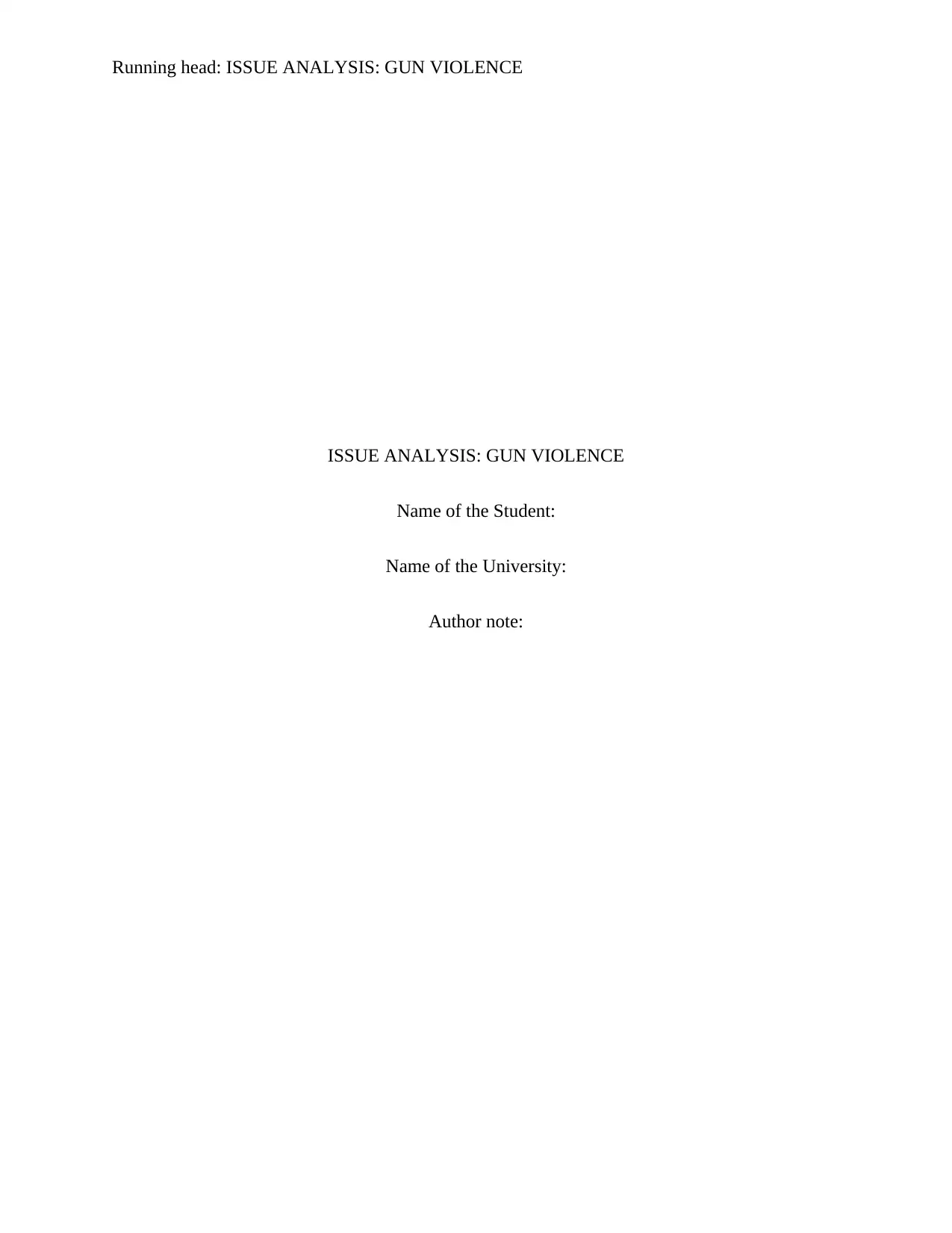
Running head: ISSUE ANALYSIS: GUN VIOLENCE
ISSUE ANALYSIS: GUN VIOLENCE
Name of the Student:
Name of the University:
Author note:
ISSUE ANALYSIS: GUN VIOLENCE
Name of the Student:
Name of the University:
Author note:
Paraphrase This Document
Need a fresh take? Get an instant paraphrase of this document with our AI Paraphraser
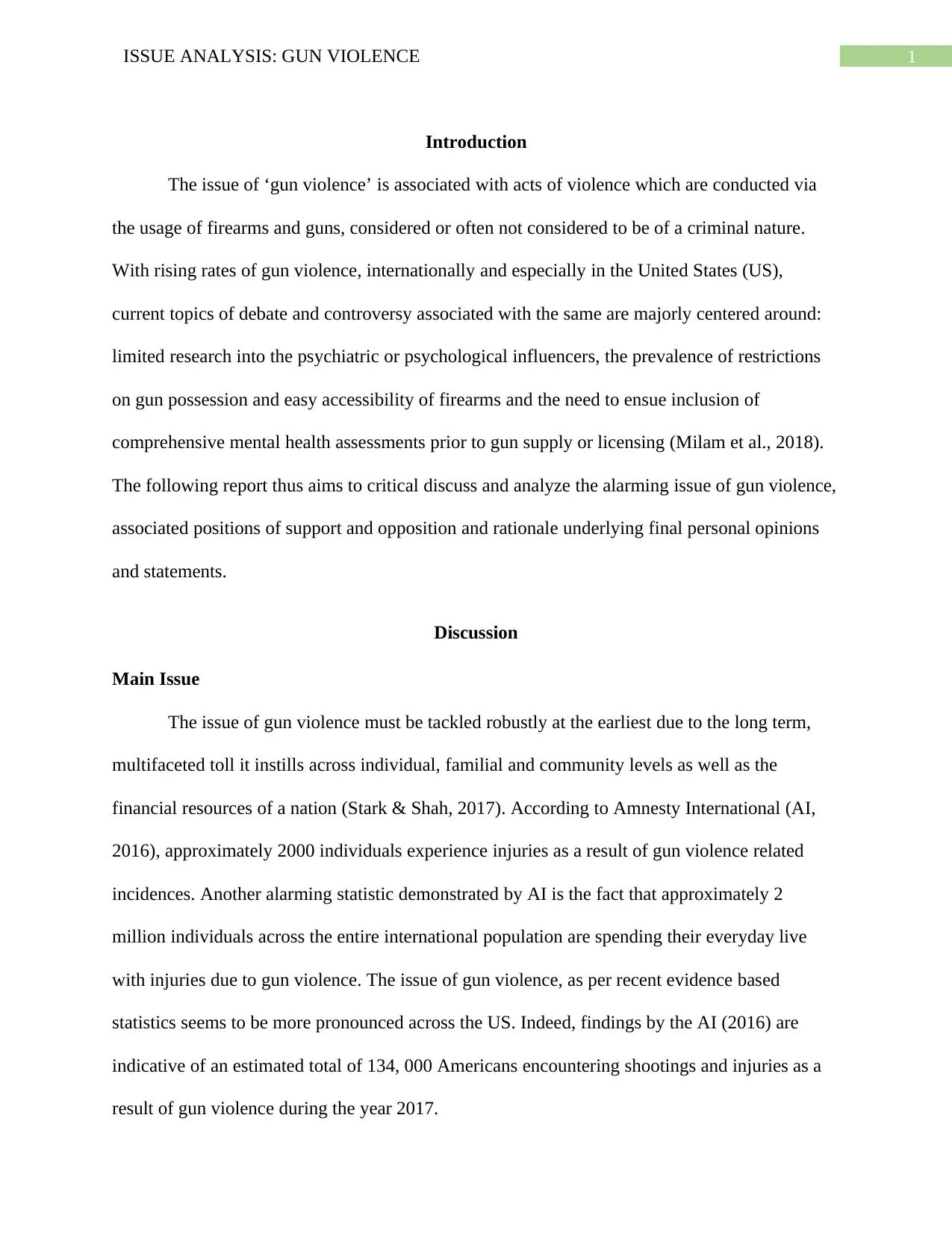
1ISSUE ANALYSIS: GUN VIOLENCE
Introduction
The issue of ‘gun violence’ is associated with acts of violence which are conducted via
the usage of firearms and guns, considered or often not considered to be of a criminal nature.
With rising rates of gun violence, internationally and especially in the United States (US),
current topics of debate and controversy associated with the same are majorly centered around:
limited research into the psychiatric or psychological influencers, the prevalence of restrictions
on gun possession and easy accessibility of firearms and the need to ensue inclusion of
comprehensive mental health assessments prior to gun supply or licensing (Milam et al., 2018).
The following report thus aims to critical discuss and analyze the alarming issue of gun violence,
associated positions of support and opposition and rationale underlying final personal opinions
and statements.
Discussion
Main Issue
The issue of gun violence must be tackled robustly at the earliest due to the long term,
multifaceted toll it instills across individual, familial and community levels as well as the
financial resources of a nation (Stark & Shah, 2017). According to Amnesty International (AI,
2016), approximately 2000 individuals experience injuries as a result of gun violence related
incidences. Another alarming statistic demonstrated by AI is the fact that approximately 2
million individuals across the entire international population are spending their everyday live
with injuries due to gun violence. The issue of gun violence, as per recent evidence based
statistics seems to be more pronounced across the US. Indeed, findings by the AI (2016) are
indicative of an estimated total of 134, 000 Americans encountering shootings and injuries as a
result of gun violence during the year 2017.
Introduction
The issue of ‘gun violence’ is associated with acts of violence which are conducted via
the usage of firearms and guns, considered or often not considered to be of a criminal nature.
With rising rates of gun violence, internationally and especially in the United States (US),
current topics of debate and controversy associated with the same are majorly centered around:
limited research into the psychiatric or psychological influencers, the prevalence of restrictions
on gun possession and easy accessibility of firearms and the need to ensue inclusion of
comprehensive mental health assessments prior to gun supply or licensing (Milam et al., 2018).
The following report thus aims to critical discuss and analyze the alarming issue of gun violence,
associated positions of support and opposition and rationale underlying final personal opinions
and statements.
Discussion
Main Issue
The issue of gun violence must be tackled robustly at the earliest due to the long term,
multifaceted toll it instills across individual, familial and community levels as well as the
financial resources of a nation (Stark & Shah, 2017). According to Amnesty International (AI,
2016), approximately 2000 individuals experience injuries as a result of gun violence related
incidences. Another alarming statistic demonstrated by AI is the fact that approximately 2
million individuals across the entire international population are spending their everyday live
with injuries due to gun violence. The issue of gun violence, as per recent evidence based
statistics seems to be more pronounced across the US. Indeed, findings by the AI (2016) are
indicative of an estimated total of 134, 000 Americans encountering shootings and injuries as a
result of gun violence during the year 2017.
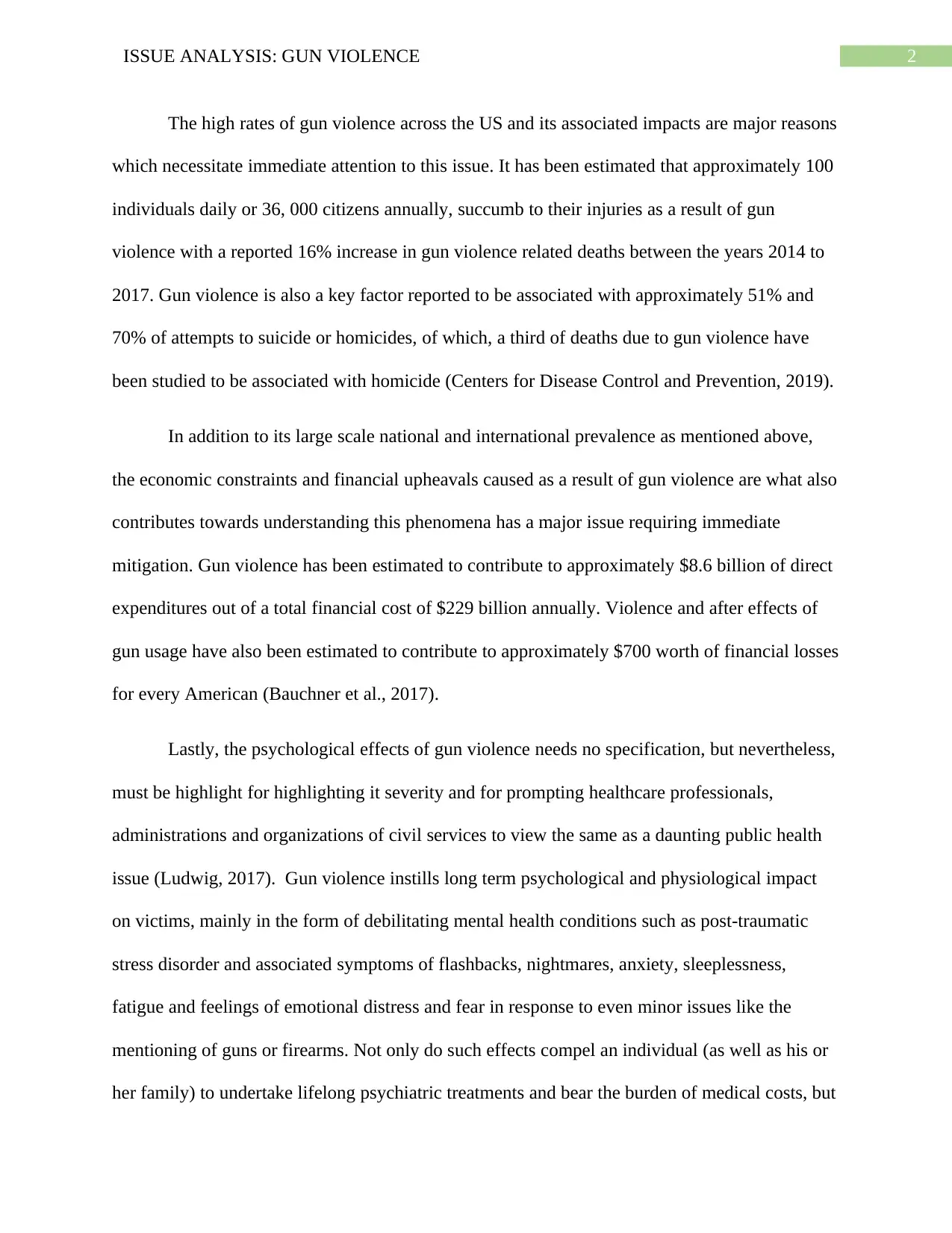
2ISSUE ANALYSIS: GUN VIOLENCE
The high rates of gun violence across the US and its associated impacts are major reasons
which necessitate immediate attention to this issue. It has been estimated that approximately 100
individuals daily or 36, 000 citizens annually, succumb to their injuries as a result of gun
violence with a reported 16% increase in gun violence related deaths between the years 2014 to
2017. Gun violence is also a key factor reported to be associated with approximately 51% and
70% of attempts to suicide or homicides, of which, a third of deaths due to gun violence have
been studied to be associated with homicide (Centers for Disease Control and Prevention, 2019).
In addition to its large scale national and international prevalence as mentioned above,
the economic constraints and financial upheavals caused as a result of gun violence are what also
contributes towards understanding this phenomena has a major issue requiring immediate
mitigation. Gun violence has been estimated to contribute to approximately $8.6 billion of direct
expenditures out of a total financial cost of $229 billion annually. Violence and after effects of
gun usage have also been estimated to contribute to approximately $700 worth of financial losses
for every American (Bauchner et al., 2017).
Lastly, the psychological effects of gun violence needs no specification, but nevertheless,
must be highlight for highlighting it severity and for prompting healthcare professionals,
administrations and organizations of civil services to view the same as a daunting public health
issue (Ludwig, 2017). Gun violence instills long term psychological and physiological impact
on victims, mainly in the form of debilitating mental health conditions such as post-traumatic
stress disorder and associated symptoms of flashbacks, nightmares, anxiety, sleeplessness,
fatigue and feelings of emotional distress and fear in response to even minor issues like the
mentioning of guns or firearms. Not only do such effects compel an individual (as well as his or
her family) to undertake lifelong psychiatric treatments and bear the burden of medical costs, but
The high rates of gun violence across the US and its associated impacts are major reasons
which necessitate immediate attention to this issue. It has been estimated that approximately 100
individuals daily or 36, 000 citizens annually, succumb to their injuries as a result of gun
violence with a reported 16% increase in gun violence related deaths between the years 2014 to
2017. Gun violence is also a key factor reported to be associated with approximately 51% and
70% of attempts to suicide or homicides, of which, a third of deaths due to gun violence have
been studied to be associated with homicide (Centers for Disease Control and Prevention, 2019).
In addition to its large scale national and international prevalence as mentioned above,
the economic constraints and financial upheavals caused as a result of gun violence are what also
contributes towards understanding this phenomena has a major issue requiring immediate
mitigation. Gun violence has been estimated to contribute to approximately $8.6 billion of direct
expenditures out of a total financial cost of $229 billion annually. Violence and after effects of
gun usage have also been estimated to contribute to approximately $700 worth of financial losses
for every American (Bauchner et al., 2017).
Lastly, the psychological effects of gun violence needs no specification, but nevertheless,
must be highlight for highlighting it severity and for prompting healthcare professionals,
administrations and organizations of civil services to view the same as a daunting public health
issue (Ludwig, 2017). Gun violence instills long term psychological and physiological impact
on victims, mainly in the form of debilitating mental health conditions such as post-traumatic
stress disorder and associated symptoms of flashbacks, nightmares, anxiety, sleeplessness,
fatigue and feelings of emotional distress and fear in response to even minor issues like the
mentioning of guns or firearms. Not only do such effects compel an individual (as well as his or
her family) to undertake lifelong psychiatric treatments and bear the burden of medical costs, but
⊘ This is a preview!⊘
Do you want full access?
Subscribe today to unlock all pages.

Trusted by 1+ million students worldwide
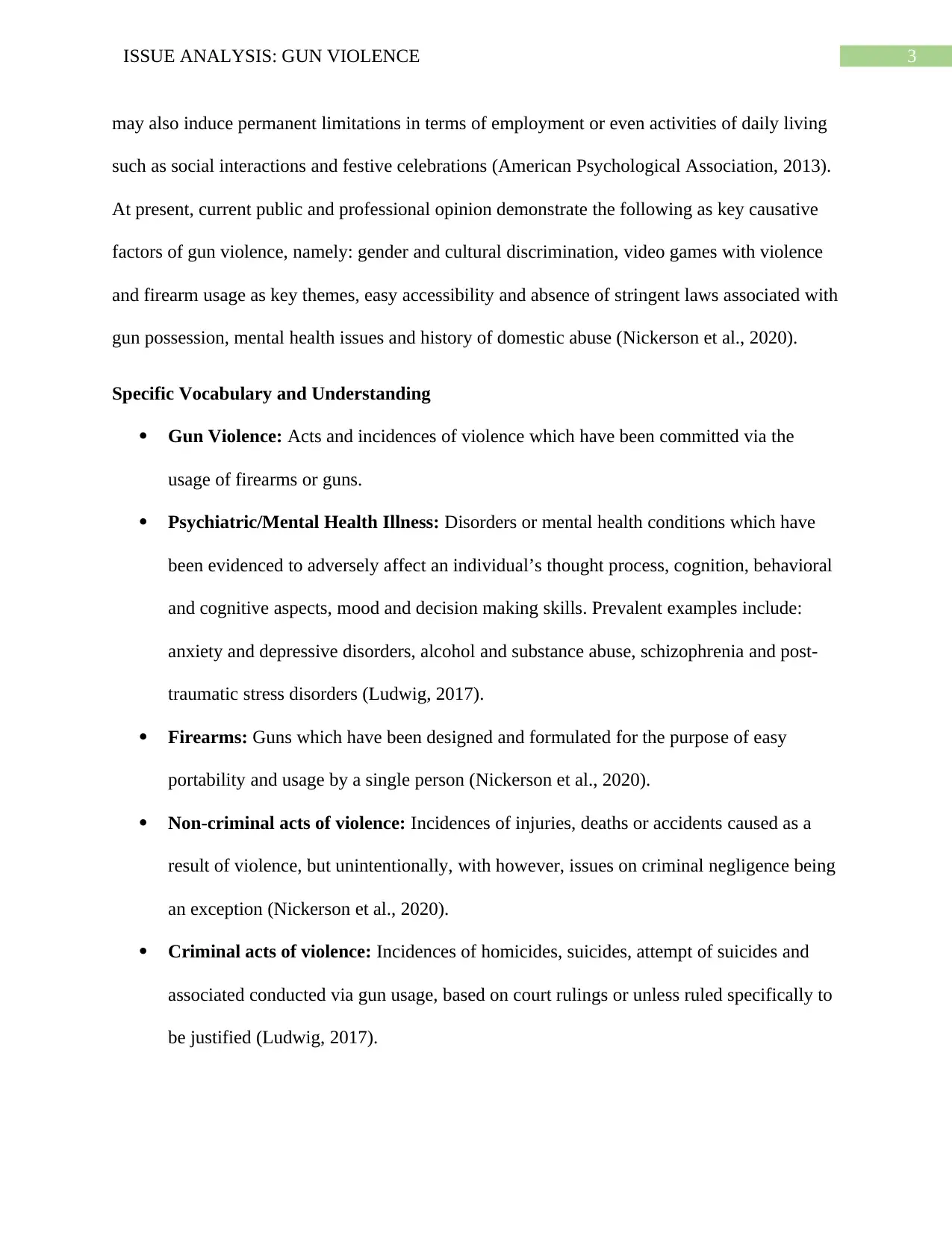
3ISSUE ANALYSIS: GUN VIOLENCE
may also induce permanent limitations in terms of employment or even activities of daily living
such as social interactions and festive celebrations (American Psychological Association, 2013).
At present, current public and professional opinion demonstrate the following as key causative
factors of gun violence, namely: gender and cultural discrimination, video games with violence
and firearm usage as key themes, easy accessibility and absence of stringent laws associated with
gun possession, mental health issues and history of domestic abuse (Nickerson et al., 2020).
Specific Vocabulary and Understanding
Gun Violence: Acts and incidences of violence which have been committed via the
usage of firearms or guns.
Psychiatric/Mental Health Illness: Disorders or mental health conditions which have
been evidenced to adversely affect an individual’s thought process, cognition, behavioral
and cognitive aspects, mood and decision making skills. Prevalent examples include:
anxiety and depressive disorders, alcohol and substance abuse, schizophrenia and post-
traumatic stress disorders (Ludwig, 2017).
Firearms: Guns which have been designed and formulated for the purpose of easy
portability and usage by a single person (Nickerson et al., 2020).
Non-criminal acts of violence: Incidences of injuries, deaths or accidents caused as a
result of violence, but unintentionally, with however, issues on criminal negligence being
an exception (Nickerson et al., 2020).
Criminal acts of violence: Incidences of homicides, suicides, attempt of suicides and
associated conducted via gun usage, based on court rulings or unless ruled specifically to
be justified (Ludwig, 2017).
may also induce permanent limitations in terms of employment or even activities of daily living
such as social interactions and festive celebrations (American Psychological Association, 2013).
At present, current public and professional opinion demonstrate the following as key causative
factors of gun violence, namely: gender and cultural discrimination, video games with violence
and firearm usage as key themes, easy accessibility and absence of stringent laws associated with
gun possession, mental health issues and history of domestic abuse (Nickerson et al., 2020).
Specific Vocabulary and Understanding
Gun Violence: Acts and incidences of violence which have been committed via the
usage of firearms or guns.
Psychiatric/Mental Health Illness: Disorders or mental health conditions which have
been evidenced to adversely affect an individual’s thought process, cognition, behavioral
and cognitive aspects, mood and decision making skills. Prevalent examples include:
anxiety and depressive disorders, alcohol and substance abuse, schizophrenia and post-
traumatic stress disorders (Ludwig, 2017).
Firearms: Guns which have been designed and formulated for the purpose of easy
portability and usage by a single person (Nickerson et al., 2020).
Non-criminal acts of violence: Incidences of injuries, deaths or accidents caused as a
result of violence, but unintentionally, with however, issues on criminal negligence being
an exception (Nickerson et al., 2020).
Criminal acts of violence: Incidences of homicides, suicides, attempt of suicides and
associated conducted via gun usage, based on court rulings or unless ruled specifically to
be justified (Ludwig, 2017).
Paraphrase This Document
Need a fresh take? Get an instant paraphrase of this document with our AI Paraphraser
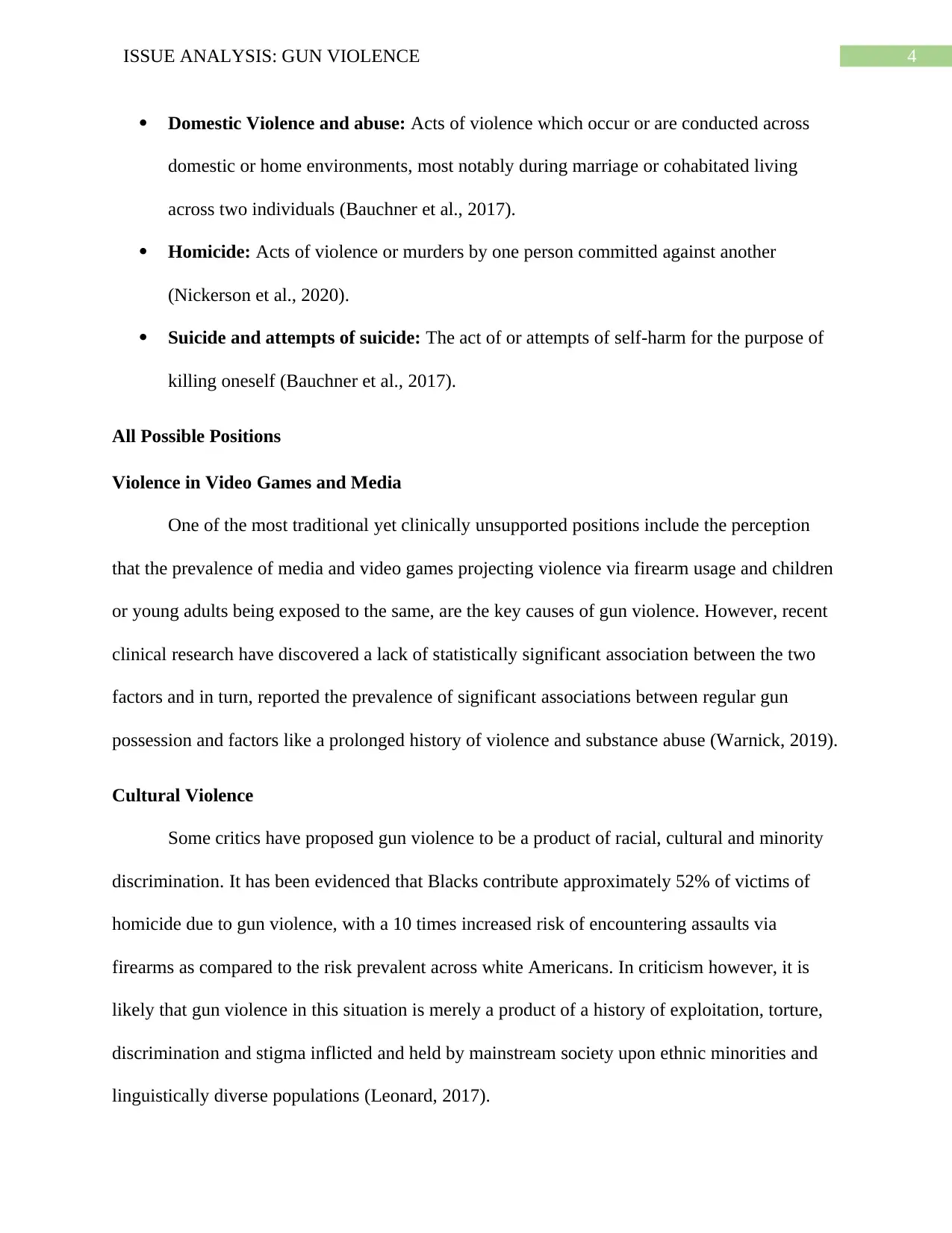
4ISSUE ANALYSIS: GUN VIOLENCE
Domestic Violence and abuse: Acts of violence which occur or are conducted across
domestic or home environments, most notably during marriage or cohabitated living
across two individuals (Bauchner et al., 2017).
Homicide: Acts of violence or murders by one person committed against another
(Nickerson et al., 2020).
Suicide and attempts of suicide: The act of or attempts of self-harm for the purpose of
killing oneself (Bauchner et al., 2017).
All Possible Positions
Violence in Video Games and Media
One of the most traditional yet clinically unsupported positions include the perception
that the prevalence of media and video games projecting violence via firearm usage and children
or young adults being exposed to the same, are the key causes of gun violence. However, recent
clinical research have discovered a lack of statistically significant association between the two
factors and in turn, reported the prevalence of significant associations between regular gun
possession and factors like a prolonged history of violence and substance abuse (Warnick, 2019).
Cultural Violence
Some critics have proposed gun violence to be a product of racial, cultural and minority
discrimination. It has been evidenced that Blacks contribute approximately 52% of victims of
homicide due to gun violence, with a 10 times increased risk of encountering assaults via
firearms as compared to the risk prevalent across white Americans. In criticism however, it is
likely that gun violence in this situation is merely a product of a history of exploitation, torture,
discrimination and stigma inflicted and held by mainstream society upon ethnic minorities and
linguistically diverse populations (Leonard, 2017).
Domestic Violence and abuse: Acts of violence which occur or are conducted across
domestic or home environments, most notably during marriage or cohabitated living
across two individuals (Bauchner et al., 2017).
Homicide: Acts of violence or murders by one person committed against another
(Nickerson et al., 2020).
Suicide and attempts of suicide: The act of or attempts of self-harm for the purpose of
killing oneself (Bauchner et al., 2017).
All Possible Positions
Violence in Video Games and Media
One of the most traditional yet clinically unsupported positions include the perception
that the prevalence of media and video games projecting violence via firearm usage and children
or young adults being exposed to the same, are the key causes of gun violence. However, recent
clinical research have discovered a lack of statistically significant association between the two
factors and in turn, reported the prevalence of significant associations between regular gun
possession and factors like a prolonged history of violence and substance abuse (Warnick, 2019).
Cultural Violence
Some critics have proposed gun violence to be a product of racial, cultural and minority
discrimination. It has been evidenced that Blacks contribute approximately 52% of victims of
homicide due to gun violence, with a 10 times increased risk of encountering assaults via
firearms as compared to the risk prevalent across white Americans. In criticism however, it is
likely that gun violence in this situation is merely a product of a history of exploitation, torture,
discrimination and stigma inflicted and held by mainstream society upon ethnic minorities and
linguistically diverse populations (Leonard, 2017).
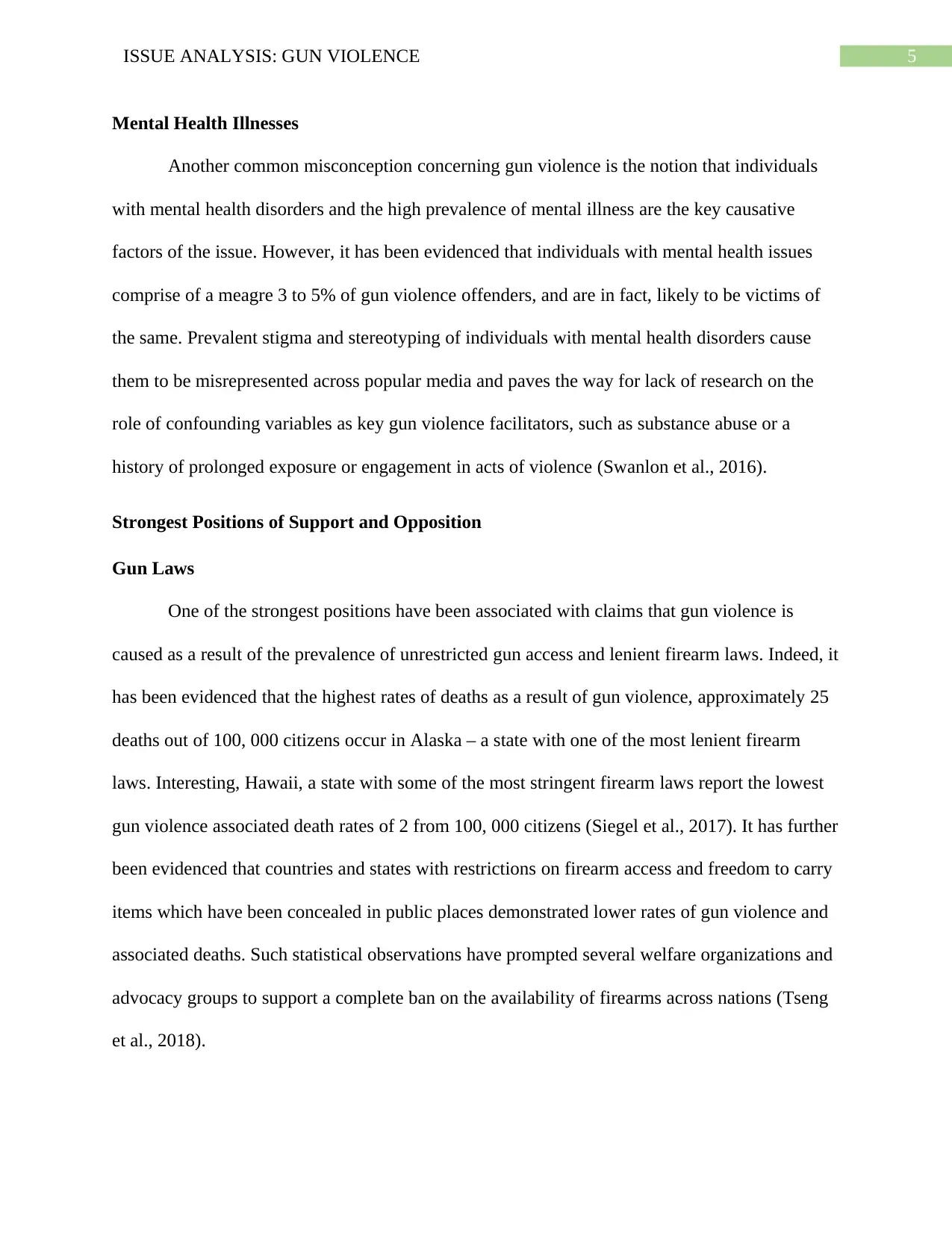
5ISSUE ANALYSIS: GUN VIOLENCE
Mental Health Illnesses
Another common misconception concerning gun violence is the notion that individuals
with mental health disorders and the high prevalence of mental illness are the key causative
factors of the issue. However, it has been evidenced that individuals with mental health issues
comprise of a meagre 3 to 5% of gun violence offenders, and are in fact, likely to be victims of
the same. Prevalent stigma and stereotyping of individuals with mental health disorders cause
them to be misrepresented across popular media and paves the way for lack of research on the
role of confounding variables as key gun violence facilitators, such as substance abuse or a
history of prolonged exposure or engagement in acts of violence (Swanlon et al., 2016).
Strongest Positions of Support and Opposition
Gun Laws
One of the strongest positions have been associated with claims that gun violence is
caused as a result of the prevalence of unrestricted gun access and lenient firearm laws. Indeed, it
has been evidenced that the highest rates of deaths as a result of gun violence, approximately 25
deaths out of 100, 000 citizens occur in Alaska – a state with one of the most lenient firearm
laws. Interesting, Hawaii, a state with some of the most stringent firearm laws report the lowest
gun violence associated death rates of 2 from 100, 000 citizens (Siegel et al., 2017). It has further
been evidenced that countries and states with restrictions on firearm access and freedom to carry
items which have been concealed in public places demonstrated lower rates of gun violence and
associated deaths. Such statistical observations have prompted several welfare organizations and
advocacy groups to support a complete ban on the availability of firearms across nations (Tseng
et al., 2018).
Mental Health Illnesses
Another common misconception concerning gun violence is the notion that individuals
with mental health disorders and the high prevalence of mental illness are the key causative
factors of the issue. However, it has been evidenced that individuals with mental health issues
comprise of a meagre 3 to 5% of gun violence offenders, and are in fact, likely to be victims of
the same. Prevalent stigma and stereotyping of individuals with mental health disorders cause
them to be misrepresented across popular media and paves the way for lack of research on the
role of confounding variables as key gun violence facilitators, such as substance abuse or a
history of prolonged exposure or engagement in acts of violence (Swanlon et al., 2016).
Strongest Positions of Support and Opposition
Gun Laws
One of the strongest positions have been associated with claims that gun violence is
caused as a result of the prevalence of unrestricted gun access and lenient firearm laws. Indeed, it
has been evidenced that the highest rates of deaths as a result of gun violence, approximately 25
deaths out of 100, 000 citizens occur in Alaska – a state with one of the most lenient firearm
laws. Interesting, Hawaii, a state with some of the most stringent firearm laws report the lowest
gun violence associated death rates of 2 from 100, 000 citizens (Siegel et al., 2017). It has further
been evidenced that countries and states with restrictions on firearm access and freedom to carry
items which have been concealed in public places demonstrated lower rates of gun violence and
associated deaths. Such statistical observations have prompted several welfare organizations and
advocacy groups to support a complete ban on the availability of firearms across nations (Tseng
et al., 2018).
⊘ This is a preview!⊘
Do you want full access?
Subscribe today to unlock all pages.

Trusted by 1+ million students worldwide
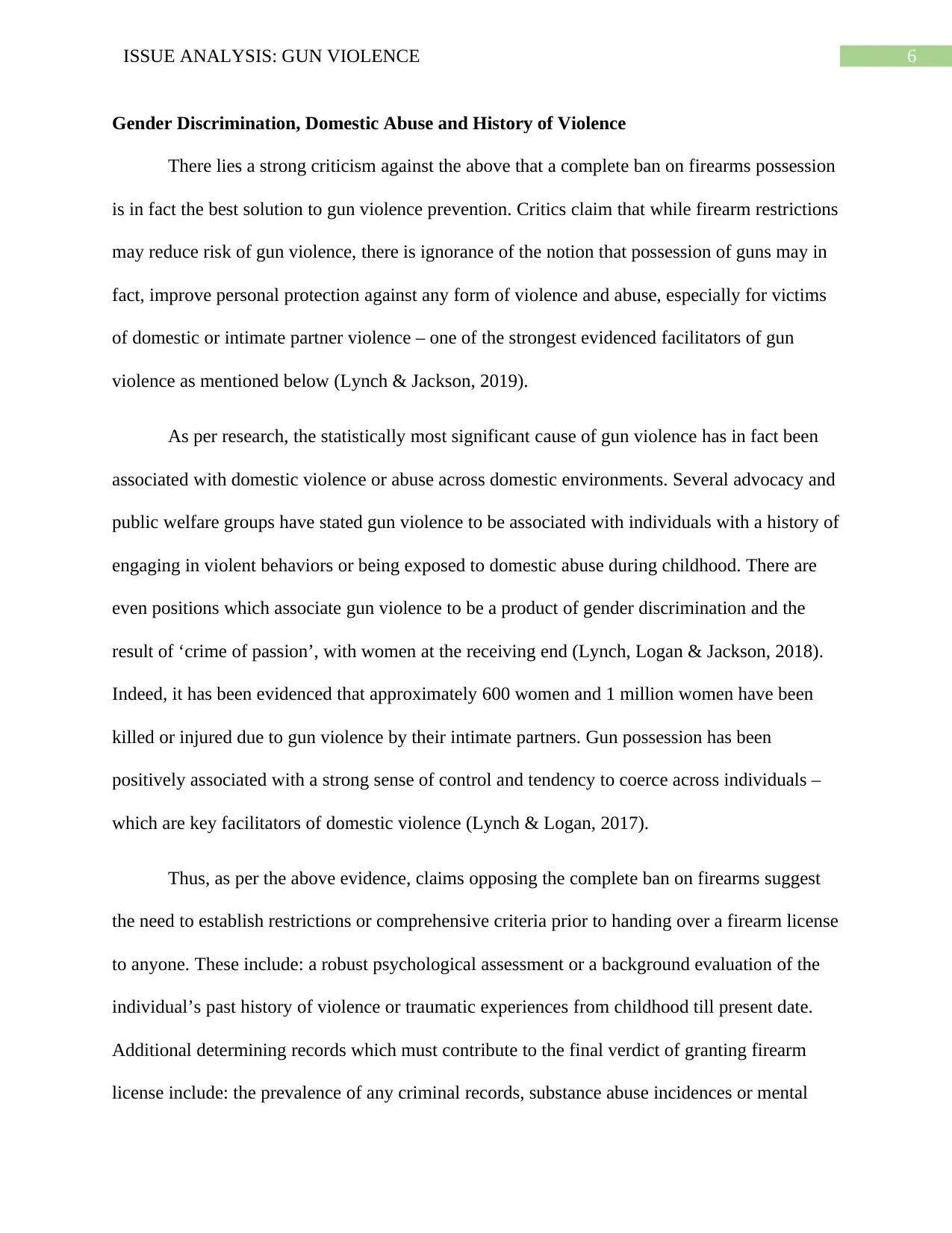
6ISSUE ANALYSIS: GUN VIOLENCE
Gender Discrimination, Domestic Abuse and History of Violence
There lies a strong criticism against the above that a complete ban on firearms possession
is in fact the best solution to gun violence prevention. Critics claim that while firearm restrictions
may reduce risk of gun violence, there is ignorance of the notion that possession of guns may in
fact, improve personal protection against any form of violence and abuse, especially for victims
of domestic or intimate partner violence – one of the strongest evidenced facilitators of gun
violence as mentioned below (Lynch & Jackson, 2019).
As per research, the statistically most significant cause of gun violence has in fact been
associated with domestic violence or abuse across domestic environments. Several advocacy and
public welfare groups have stated gun violence to be associated with individuals with a history of
engaging in violent behaviors or being exposed to domestic abuse during childhood. There are
even positions which associate gun violence to be a product of gender discrimination and the
result of ‘crime of passion’, with women at the receiving end (Lynch, Logan & Jackson, 2018).
Indeed, it has been evidenced that approximately 600 women and 1 million women have been
killed or injured due to gun violence by their intimate partners. Gun possession has been
positively associated with a strong sense of control and tendency to coerce across individuals –
which are key facilitators of domestic violence (Lynch & Logan, 2017).
Thus, as per the above evidence, claims opposing the complete ban on firearms suggest
the need to establish restrictions or comprehensive criteria prior to handing over a firearm license
to anyone. These include: a robust psychological assessment or a background evaluation of the
individual’s past history of violence or traumatic experiences from childhood till present date.
Additional determining records which must contribute to the final verdict of granting firearm
license include: the prevalence of any criminal records, substance abuse incidences or mental
Gender Discrimination, Domestic Abuse and History of Violence
There lies a strong criticism against the above that a complete ban on firearms possession
is in fact the best solution to gun violence prevention. Critics claim that while firearm restrictions
may reduce risk of gun violence, there is ignorance of the notion that possession of guns may in
fact, improve personal protection against any form of violence and abuse, especially for victims
of domestic or intimate partner violence – one of the strongest evidenced facilitators of gun
violence as mentioned below (Lynch & Jackson, 2019).
As per research, the statistically most significant cause of gun violence has in fact been
associated with domestic violence or abuse across domestic environments. Several advocacy and
public welfare groups have stated gun violence to be associated with individuals with a history of
engaging in violent behaviors or being exposed to domestic abuse during childhood. There are
even positions which associate gun violence to be a product of gender discrimination and the
result of ‘crime of passion’, with women at the receiving end (Lynch, Logan & Jackson, 2018).
Indeed, it has been evidenced that approximately 600 women and 1 million women have been
killed or injured due to gun violence by their intimate partners. Gun possession has been
positively associated with a strong sense of control and tendency to coerce across individuals –
which are key facilitators of domestic violence (Lynch & Logan, 2017).
Thus, as per the above evidence, claims opposing the complete ban on firearms suggest
the need to establish restrictions or comprehensive criteria prior to handing over a firearm license
to anyone. These include: a robust psychological assessment or a background evaluation of the
individual’s past history of violence or traumatic experiences from childhood till present date.
Additional determining records which must contribute to the final verdict of granting firearm
license include: the prevalence of any criminal records, substance abuse incidences or mental
Paraphrase This Document
Need a fresh take? Get an instant paraphrase of this document with our AI Paraphraser
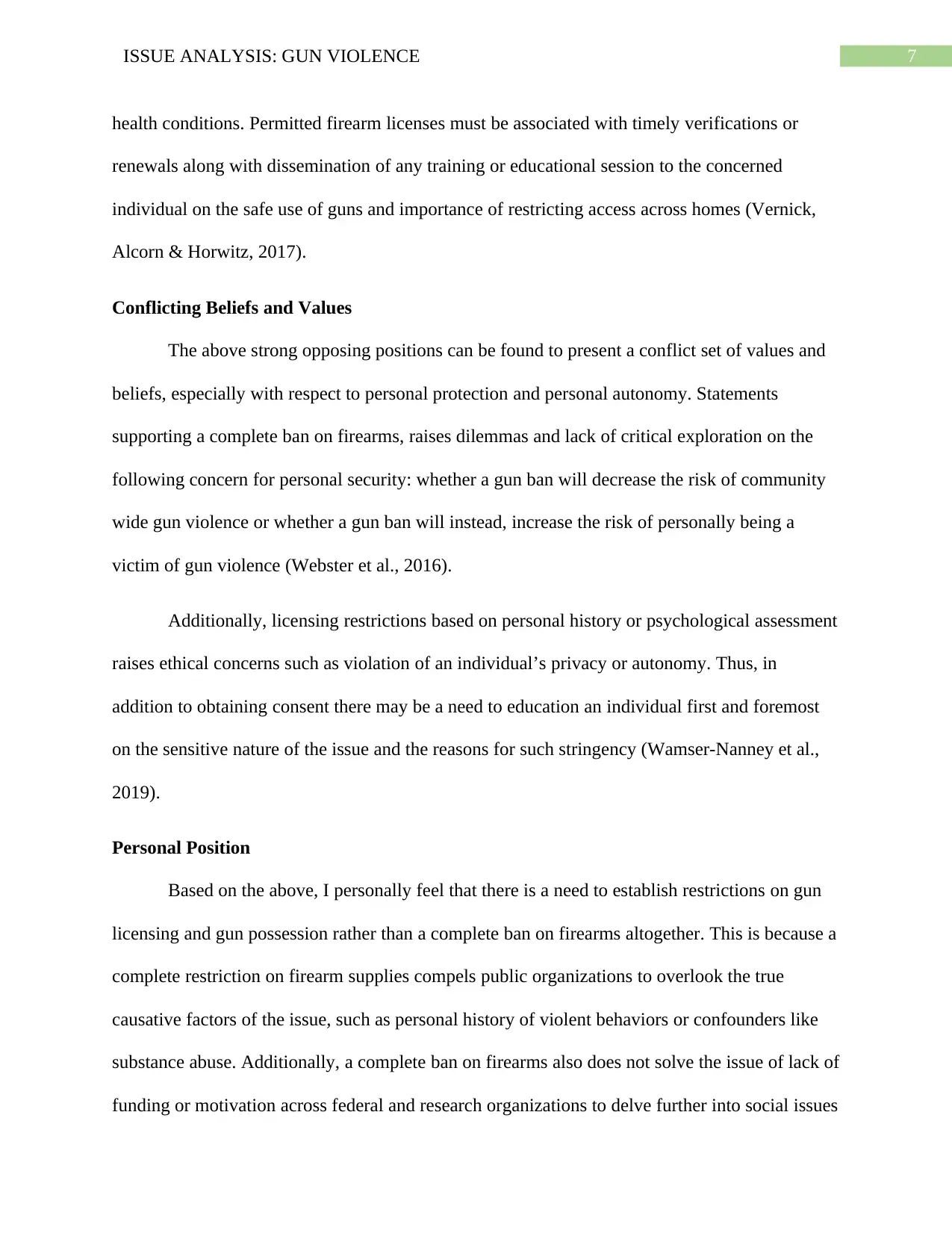
7ISSUE ANALYSIS: GUN VIOLENCE
health conditions. Permitted firearm licenses must be associated with timely verifications or
renewals along with dissemination of any training or educational session to the concerned
individual on the safe use of guns and importance of restricting access across homes (Vernick,
Alcorn & Horwitz, 2017).
Conflicting Beliefs and Values
The above strong opposing positions can be found to present a conflict set of values and
beliefs, especially with respect to personal protection and personal autonomy. Statements
supporting a complete ban on firearms, raises dilemmas and lack of critical exploration on the
following concern for personal security: whether a gun ban will decrease the risk of community
wide gun violence or whether a gun ban will instead, increase the risk of personally being a
victim of gun violence (Webster et al., 2016).
Additionally, licensing restrictions based on personal history or psychological assessment
raises ethical concerns such as violation of an individual’s privacy or autonomy. Thus, in
addition to obtaining consent there may be a need to education an individual first and foremost
on the sensitive nature of the issue and the reasons for such stringency (Wamser-Nanney et al.,
2019).
Personal Position
Based on the above, I personally feel that there is a need to establish restrictions on gun
licensing and gun possession rather than a complete ban on firearms altogether. This is because a
complete restriction on firearm supplies compels public organizations to overlook the true
causative factors of the issue, such as personal history of violent behaviors or confounders like
substance abuse. Additionally, a complete ban on firearms also does not solve the issue of lack of
funding or motivation across federal and research organizations to delve further into social issues
health conditions. Permitted firearm licenses must be associated with timely verifications or
renewals along with dissemination of any training or educational session to the concerned
individual on the safe use of guns and importance of restricting access across homes (Vernick,
Alcorn & Horwitz, 2017).
Conflicting Beliefs and Values
The above strong opposing positions can be found to present a conflict set of values and
beliefs, especially with respect to personal protection and personal autonomy. Statements
supporting a complete ban on firearms, raises dilemmas and lack of critical exploration on the
following concern for personal security: whether a gun ban will decrease the risk of community
wide gun violence or whether a gun ban will instead, increase the risk of personally being a
victim of gun violence (Webster et al., 2016).
Additionally, licensing restrictions based on personal history or psychological assessment
raises ethical concerns such as violation of an individual’s privacy or autonomy. Thus, in
addition to obtaining consent there may be a need to education an individual first and foremost
on the sensitive nature of the issue and the reasons for such stringency (Wamser-Nanney et al.,
2019).
Personal Position
Based on the above, I personally feel that there is a need to establish restrictions on gun
licensing and gun possession rather than a complete ban on firearms altogether. This is because a
complete restriction on firearm supplies compels public organizations to overlook the true
causative factors of the issue, such as personal history of violent behaviors or confounders like
substance abuse. Additionally, a complete ban on firearms also does not solve the issue of lack of
funding or motivation across federal and research organizations to delve further into social issues
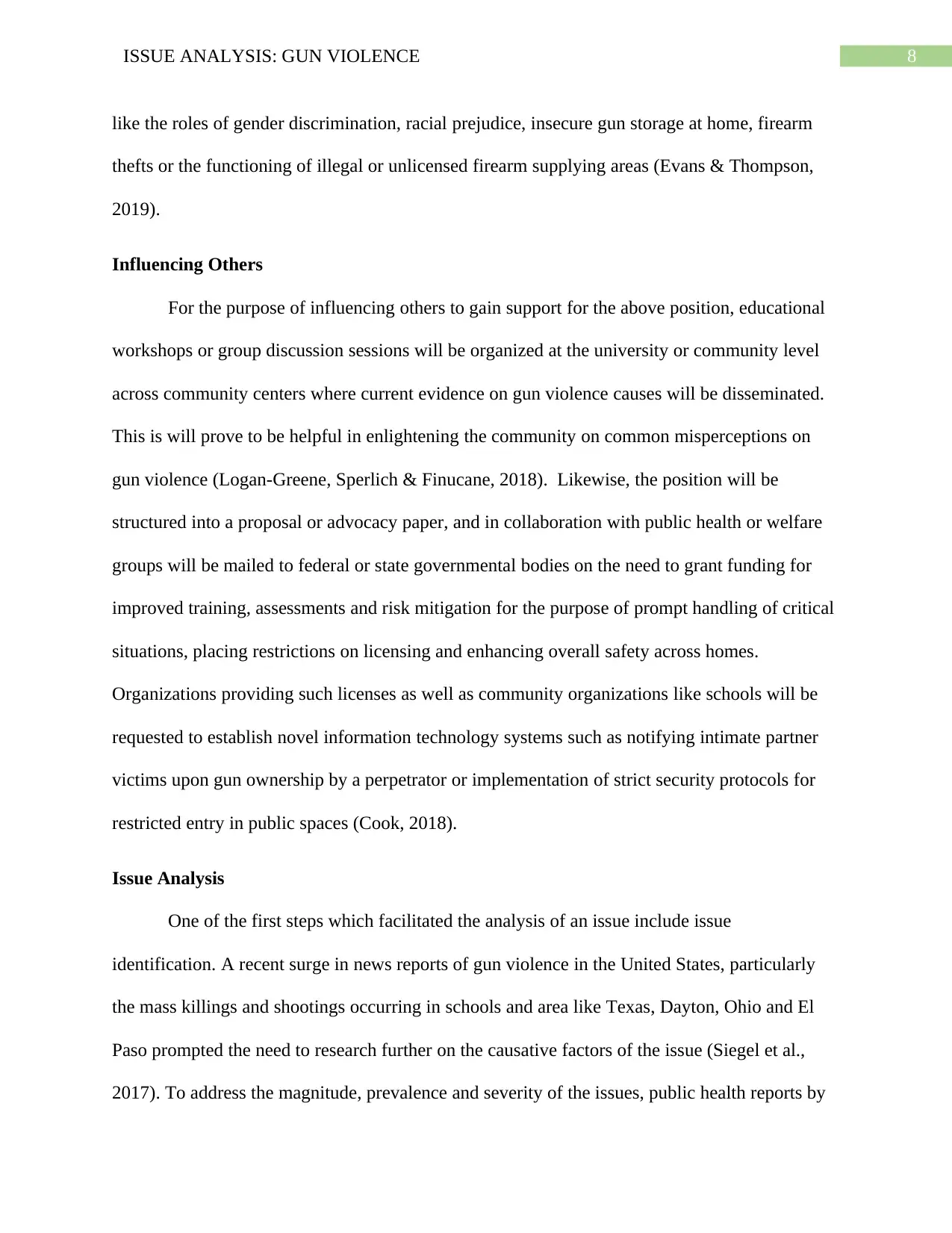
8ISSUE ANALYSIS: GUN VIOLENCE
like the roles of gender discrimination, racial prejudice, insecure gun storage at home, firearm
thefts or the functioning of illegal or unlicensed firearm supplying areas (Evans & Thompson,
2019).
Influencing Others
For the purpose of influencing others to gain support for the above position, educational
workshops or group discussion sessions will be organized at the university or community level
across community centers where current evidence on gun violence causes will be disseminated.
This is will prove to be helpful in enlightening the community on common misperceptions on
gun violence (Logan-Greene, Sperlich & Finucane, 2018). Likewise, the position will be
structured into a proposal or advocacy paper, and in collaboration with public health or welfare
groups will be mailed to federal or state governmental bodies on the need to grant funding for
improved training, assessments and risk mitigation for the purpose of prompt handling of critical
situations, placing restrictions on licensing and enhancing overall safety across homes.
Organizations providing such licenses as well as community organizations like schools will be
requested to establish novel information technology systems such as notifying intimate partner
victims upon gun ownership by a perpetrator or implementation of strict security protocols for
restricted entry in public spaces (Cook, 2018).
Issue Analysis
One of the first steps which facilitated the analysis of an issue include issue
identification. A recent surge in news reports of gun violence in the United States, particularly
the mass killings and shootings occurring in schools and area like Texas, Dayton, Ohio and El
Paso prompted the need to research further on the causative factors of the issue (Siegel et al.,
2017). To address the magnitude, prevalence and severity of the issues, public health reports by
like the roles of gender discrimination, racial prejudice, insecure gun storage at home, firearm
thefts or the functioning of illegal or unlicensed firearm supplying areas (Evans & Thompson,
2019).
Influencing Others
For the purpose of influencing others to gain support for the above position, educational
workshops or group discussion sessions will be organized at the university or community level
across community centers where current evidence on gun violence causes will be disseminated.
This is will prove to be helpful in enlightening the community on common misperceptions on
gun violence (Logan-Greene, Sperlich & Finucane, 2018). Likewise, the position will be
structured into a proposal or advocacy paper, and in collaboration with public health or welfare
groups will be mailed to federal or state governmental bodies on the need to grant funding for
improved training, assessments and risk mitigation for the purpose of prompt handling of critical
situations, placing restrictions on licensing and enhancing overall safety across homes.
Organizations providing such licenses as well as community organizations like schools will be
requested to establish novel information technology systems such as notifying intimate partner
victims upon gun ownership by a perpetrator or implementation of strict security protocols for
restricted entry in public spaces (Cook, 2018).
Issue Analysis
One of the first steps which facilitated the analysis of an issue include issue
identification. A recent surge in news reports of gun violence in the United States, particularly
the mass killings and shootings occurring in schools and area like Texas, Dayton, Ohio and El
Paso prompted the need to research further on the causative factors of the issue (Siegel et al.,
2017). To address the magnitude, prevalence and severity of the issues, public health reports by
⊘ This is a preview!⊘
Do you want full access?
Subscribe today to unlock all pages.

Trusted by 1+ million students worldwide
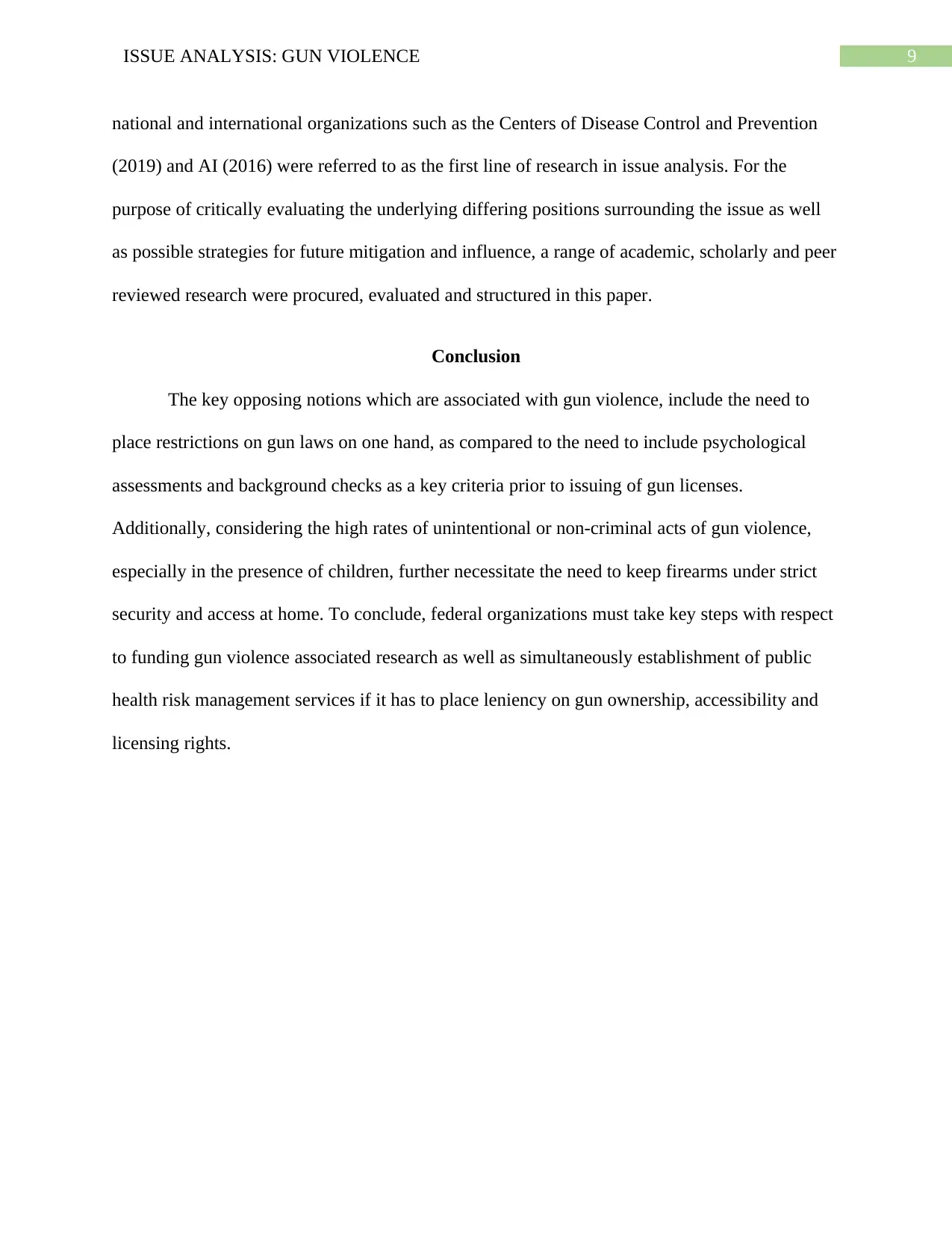
9ISSUE ANALYSIS: GUN VIOLENCE
national and international organizations such as the Centers of Disease Control and Prevention
(2019) and AI (2016) were referred to as the first line of research in issue analysis. For the
purpose of critically evaluating the underlying differing positions surrounding the issue as well
as possible strategies for future mitigation and influence, a range of academic, scholarly and peer
reviewed research were procured, evaluated and structured in this paper.
Conclusion
The key opposing notions which are associated with gun violence, include the need to
place restrictions on gun laws on one hand, as compared to the need to include psychological
assessments and background checks as a key criteria prior to issuing of gun licenses.
Additionally, considering the high rates of unintentional or non-criminal acts of gun violence,
especially in the presence of children, further necessitate the need to keep firearms under strict
security and access at home. To conclude, federal organizations must take key steps with respect
to funding gun violence associated research as well as simultaneously establishment of public
health risk management services if it has to place leniency on gun ownership, accessibility and
licensing rights.
national and international organizations such as the Centers of Disease Control and Prevention
(2019) and AI (2016) were referred to as the first line of research in issue analysis. For the
purpose of critically evaluating the underlying differing positions surrounding the issue as well
as possible strategies for future mitigation and influence, a range of academic, scholarly and peer
reviewed research were procured, evaluated and structured in this paper.
Conclusion
The key opposing notions which are associated with gun violence, include the need to
place restrictions on gun laws on one hand, as compared to the need to include psychological
assessments and background checks as a key criteria prior to issuing of gun licenses.
Additionally, considering the high rates of unintentional or non-criminal acts of gun violence,
especially in the presence of children, further necessitate the need to keep firearms under strict
security and access at home. To conclude, federal organizations must take key steps with respect
to funding gun violence associated research as well as simultaneously establishment of public
health risk management services if it has to place leniency on gun ownership, accessibility and
licensing rights.
Paraphrase This Document
Need a fresh take? Get an instant paraphrase of this document with our AI Paraphraser
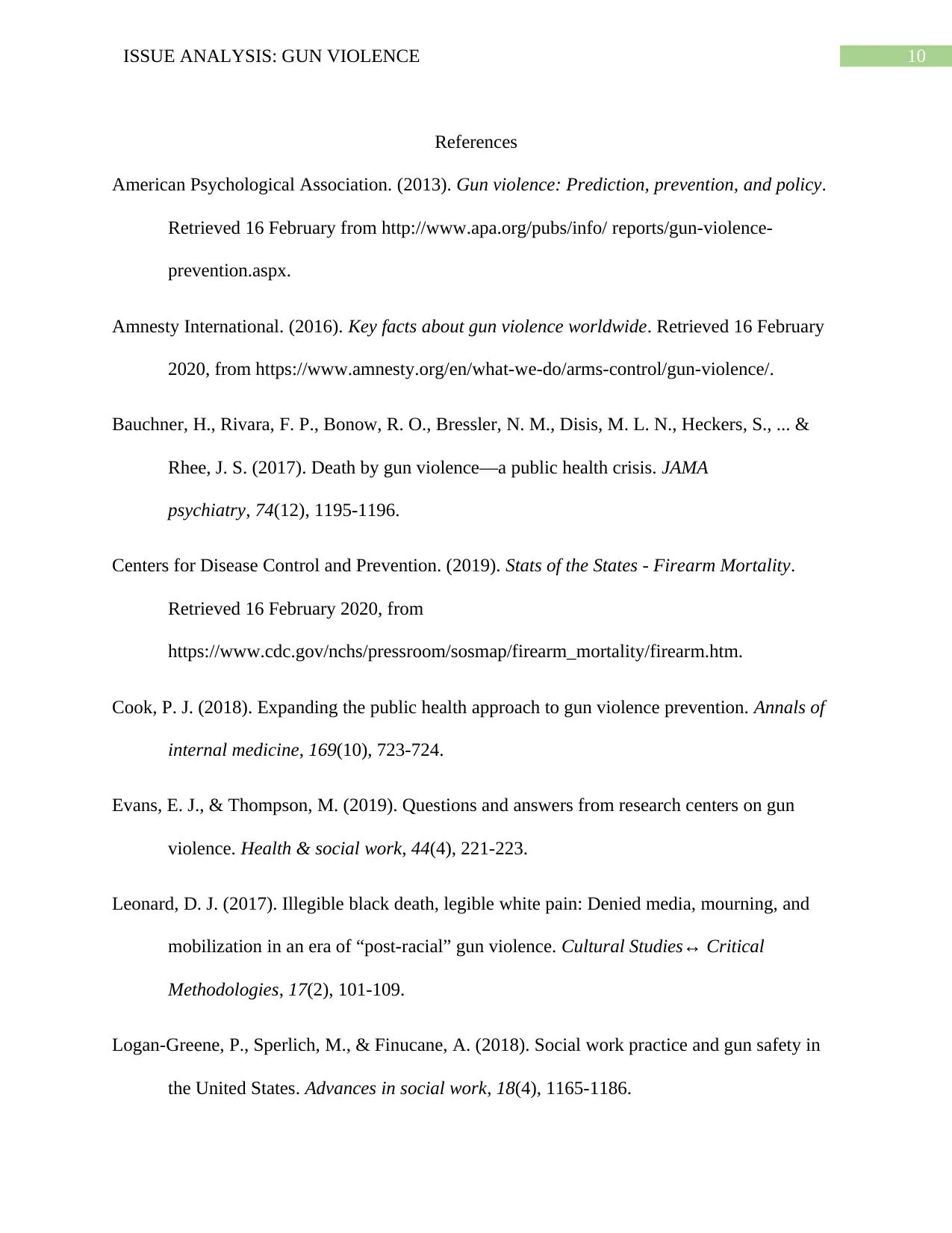
10ISSUE ANALYSIS: GUN VIOLENCE
References
American Psychological Association. (2013). Gun violence: Prediction, prevention, and policy.
Retrieved 16 February from http://www.apa.org/pubs/info/ reports/gun-violence-
prevention.aspx.
Amnesty International. (2016). Key facts about gun violence worldwide. Retrieved 16 February
2020, from https://www.amnesty.org/en/what-we-do/arms-control/gun-violence/.
Bauchner, H., Rivara, F. P., Bonow, R. O., Bressler, N. M., Disis, M. L. N., Heckers, S., ... &
Rhee, J. S. (2017). Death by gun violence—a public health crisis. JAMA
psychiatry, 74(12), 1195-1196.
Centers for Disease Control and Prevention. (2019). Stats of the States - Firearm Mortality.
Retrieved 16 February 2020, from
https://www.cdc.gov/nchs/pressroom/sosmap/firearm_mortality/firearm.htm.
Cook, P. J. (2018). Expanding the public health approach to gun violence prevention. Annals of
internal medicine, 169(10), 723-724.
Evans, E. J., & Thompson, M. (2019). Questions and answers from research centers on gun
violence. Health & social work, 44(4), 221-223.
Leonard, D. J. (2017). Illegible black death, legible white pain: Denied media, mourning, and
mobilization in an era of “post-racial” gun violence. Cultural Studies↔ Critical
Methodologies, 17(2), 101-109.
Logan-Greene, P., Sperlich, M., & Finucane, A. (2018). Social work practice and gun safety in
the United States. Advances in social work, 18(4), 1165-1186.
References
American Psychological Association. (2013). Gun violence: Prediction, prevention, and policy.
Retrieved 16 February from http://www.apa.org/pubs/info/ reports/gun-violence-
prevention.aspx.
Amnesty International. (2016). Key facts about gun violence worldwide. Retrieved 16 February
2020, from https://www.amnesty.org/en/what-we-do/arms-control/gun-violence/.
Bauchner, H., Rivara, F. P., Bonow, R. O., Bressler, N. M., Disis, M. L. N., Heckers, S., ... &
Rhee, J. S. (2017). Death by gun violence—a public health crisis. JAMA
psychiatry, 74(12), 1195-1196.
Centers for Disease Control and Prevention. (2019). Stats of the States - Firearm Mortality.
Retrieved 16 February 2020, from
https://www.cdc.gov/nchs/pressroom/sosmap/firearm_mortality/firearm.htm.
Cook, P. J. (2018). Expanding the public health approach to gun violence prevention. Annals of
internal medicine, 169(10), 723-724.
Evans, E. J., & Thompson, M. (2019). Questions and answers from research centers on gun
violence. Health & social work, 44(4), 221-223.
Leonard, D. J. (2017). Illegible black death, legible white pain: Denied media, mourning, and
mobilization in an era of “post-racial” gun violence. Cultural Studies↔ Critical
Methodologies, 17(2), 101-109.
Logan-Greene, P., Sperlich, M., & Finucane, A. (2018). Social work practice and gun safety in
the United States. Advances in social work, 18(4), 1165-1186.
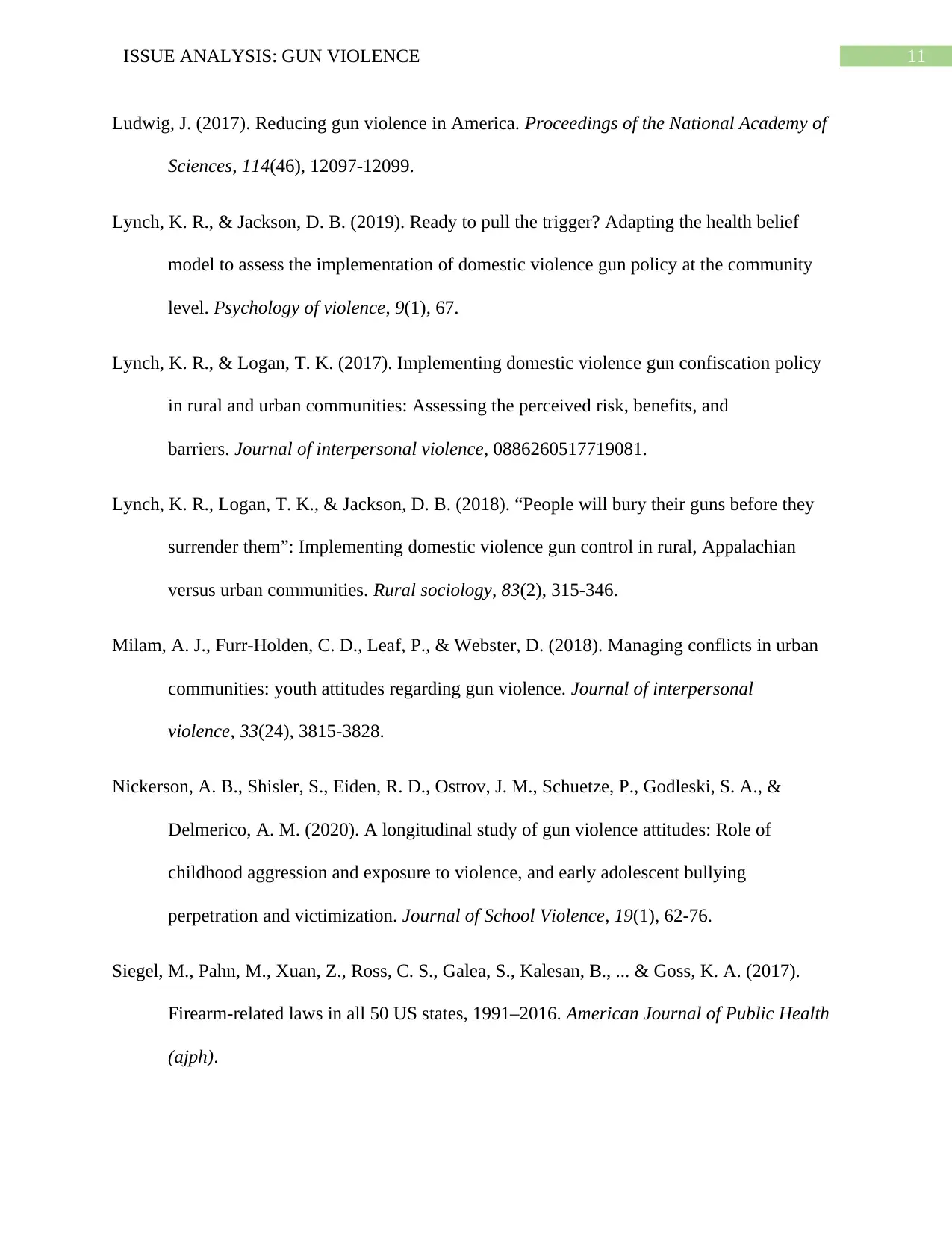
11ISSUE ANALYSIS: GUN VIOLENCE
Ludwig, J. (2017). Reducing gun violence in America. Proceedings of the National Academy of
Sciences, 114(46), 12097-12099.
Lynch, K. R., & Jackson, D. B. (2019). Ready to pull the trigger? Adapting the health belief
model to assess the implementation of domestic violence gun policy at the community
level. Psychology of violence, 9(1), 67.
Lynch, K. R., & Logan, T. K. (2017). Implementing domestic violence gun confiscation policy
in rural and urban communities: Assessing the perceived risk, benefits, and
barriers. Journal of interpersonal violence, 0886260517719081.
Lynch, K. R., Logan, T. K., & Jackson, D. B. (2018). “People will bury their guns before they
surrender them”: Implementing domestic violence gun control in rural, Appalachian
versus urban communities. Rural sociology, 83(2), 315-346.
Milam, A. J., Furr-Holden, C. D., Leaf, P., & Webster, D. (2018). Managing conflicts in urban
communities: youth attitudes regarding gun violence. Journal of interpersonal
violence, 33(24), 3815-3828.
Nickerson, A. B., Shisler, S., Eiden, R. D., Ostrov, J. M., Schuetze, P., Godleski, S. A., &
Delmerico, A. M. (2020). A longitudinal study of gun violence attitudes: Role of
childhood aggression and exposure to violence, and early adolescent bullying
perpetration and victimization. Journal of School Violence, 19(1), 62-76.
Siegel, M., Pahn, M., Xuan, Z., Ross, C. S., Galea, S., Kalesan, B., ... & Goss, K. A. (2017).
Firearm-related laws in all 50 US states, 1991–2016. American Journal of Public Health
(ajph).
Ludwig, J. (2017). Reducing gun violence in America. Proceedings of the National Academy of
Sciences, 114(46), 12097-12099.
Lynch, K. R., & Jackson, D. B. (2019). Ready to pull the trigger? Adapting the health belief
model to assess the implementation of domestic violence gun policy at the community
level. Psychology of violence, 9(1), 67.
Lynch, K. R., & Logan, T. K. (2017). Implementing domestic violence gun confiscation policy
in rural and urban communities: Assessing the perceived risk, benefits, and
barriers. Journal of interpersonal violence, 0886260517719081.
Lynch, K. R., Logan, T. K., & Jackson, D. B. (2018). “People will bury their guns before they
surrender them”: Implementing domestic violence gun control in rural, Appalachian
versus urban communities. Rural sociology, 83(2), 315-346.
Milam, A. J., Furr-Holden, C. D., Leaf, P., & Webster, D. (2018). Managing conflicts in urban
communities: youth attitudes regarding gun violence. Journal of interpersonal
violence, 33(24), 3815-3828.
Nickerson, A. B., Shisler, S., Eiden, R. D., Ostrov, J. M., Schuetze, P., Godleski, S. A., &
Delmerico, A. M. (2020). A longitudinal study of gun violence attitudes: Role of
childhood aggression and exposure to violence, and early adolescent bullying
perpetration and victimization. Journal of School Violence, 19(1), 62-76.
Siegel, M., Pahn, M., Xuan, Z., Ross, C. S., Galea, S., Kalesan, B., ... & Goss, K. A. (2017).
Firearm-related laws in all 50 US states, 1991–2016. American Journal of Public Health
(ajph).
⊘ This is a preview!⊘
Do you want full access?
Subscribe today to unlock all pages.

Trusted by 1+ million students worldwide
1 out of 13
Your All-in-One AI-Powered Toolkit for Academic Success.
+13062052269
info@desklib.com
Available 24*7 on WhatsApp / Email
![[object Object]](/_next/static/media/star-bottom.7253800d.svg)
Unlock your academic potential
Copyright © 2020–2025 A2Z Services. All Rights Reserved. Developed and managed by ZUCOL.


